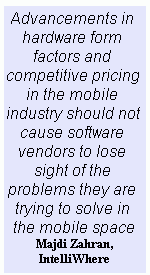
Mobile computing is defined as using a portable computing device while in transit or in a remote location.It's basically computing on the go. This is a general definition and any device that meets these criteria could technically be characterized as mobile.The Tablet PC is definitely mobile and is powerful enough to run desktop applications.Many mobile users welcome such devices and see the value of having such power, performance and capacity. At the same time, some software solutions vendors focus on the form factor of such devices and loose site of the true mobile requirements in the field and the problems it is expected to solve.
It's crucial to step back and evaluate mobile solutions from a field user's point of view, to better understand what exactly are the pain points. Vendors who create the mobile software solutions need to first focus on what is needed by an enterprise's mobile and field users.Understanding those needs is paramount to providing solutions that will be adopted in the mobile market.Technology should be seen as an enabler not the main driver of the end solution.This doesn't mean technology cannot drive some parts of the process.Without innovative technology vendors the industry would not have many of the mobile solutions it has today.But we need to be careful not to loose site of what problems we are trying to solve in this space.Some of the high level requirements for mobile users are:
- Software and hardware tools that enable jobs to be done better and faster.
- Access to corporate information when needed.
- Automate and enhance the process of incorporating captured field data into a corporate system or enterprise in a streamlined workflow that enables quick access to the most up-to-date corporate information.
- Solutions that are easy to use, performant and stable - ease of use is a crucial requirement that can mean adoption of the solution.
- Device independence - field users have many different tasks with varying degrees of complexity and device requirements and mobile crews need to be agile in response.Solutions that are device independent enable mobile crews to respond without having to retool each time.
- Network independence - Mobile users need software solutions that are network independent and occasionally connected.This means users can continue performing tasks when there is no network coverage without loosing any of their work.
 The
mobile staff supervisors who are responsible for managing the field crews
have another set of requirements that must be adequately addressed by the
solutions they use.Some of those requirements include:
The
mobile staff supervisors who are responsible for managing the field crews
have another set of requirements that must be adequately addressed by the
solutions they use.Some of those requirements include:
- Mobile crews presence management - also called "Tracking and management," supervisors need to know where their field crews are and their progress in their daily tasks and along an assigned route.
- Dispatching jobs or tasks to the mobile crew in real time, based on pre-defined business rules.
- Adaptive systems to respond to unplanned events or situations.
- Five rights of mobile solutions - the ability to assign the right job to the right resource with the right equipment in the right location at the right time.
- Incorporating information about location, job asset, and field status in real time.
- Full audit trails and reporting to enable planning and process improvements.
- Homeland security and regulatory compliance.
- Interoperability - mobile solutions must be able to leverage existing corporate investments and work with enterprise systems, such as, work management, CRM, HR, asset management and call centers.Redeploying corporate systems for the sake of mobile solutions is not an acceptable option.
- Solutions based on open standards to guarantee future IT investment and improved IT support.
- Commercial-off-the-shelf (COTS) mobile software solutions.
- Scalability - to meet future demands and growth.
- Security - solutions should extend over potentially unprotected networks while still preserving the integrity of user data and protect against security breaches.